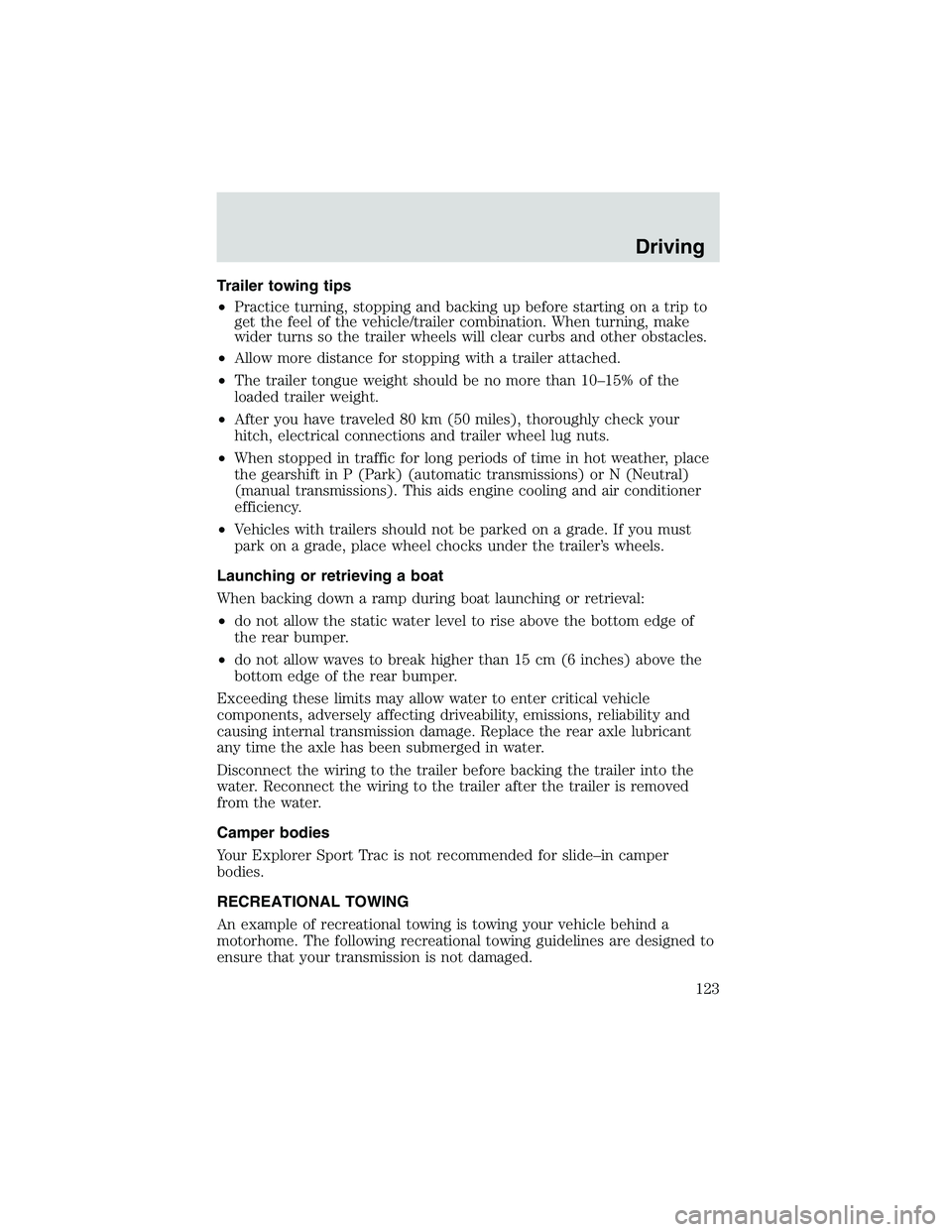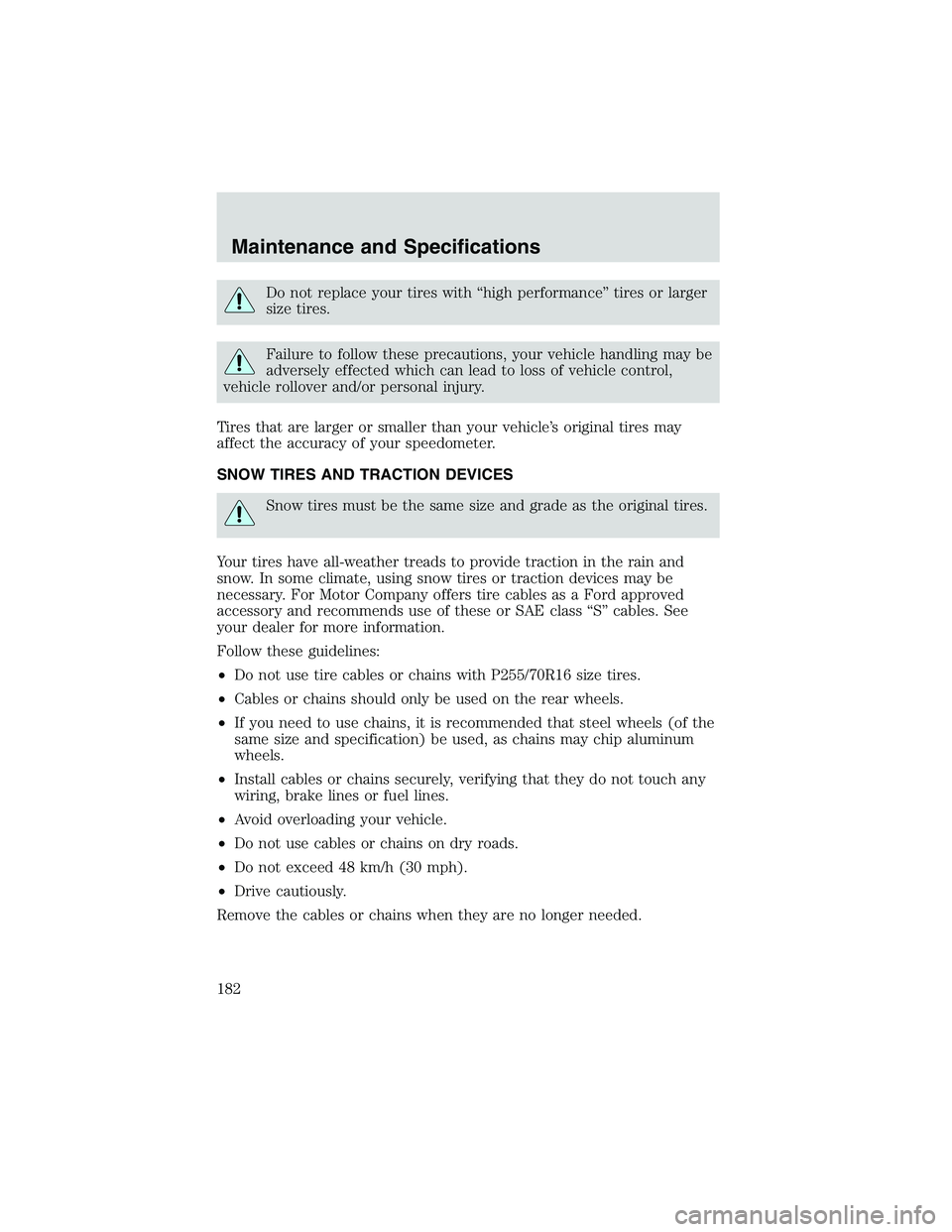Page 87 of 200

•a readiness light and tone
•a diagnostic module
•and the electrical wiring which connects the components
Several air bag system components get hot after inflation. Do not
touch them after inflation.
If the air bag has deployed,the air bag will not function
again and must be replaced immediately.If the air bag is not
replaced, the unrepaired area will increase the risk of injury in a
collision.
Determining if the system is operational
The SRS uses a readiness light in the instrument cluster or a tone to
indicate the status of the system. Refer toAir bag readinesssection in
theInstrument clusterchapter. Routine maintenance of the air bag is
not required.
A difficulty with the system is indicated by one or more of the following:
•The readiness light will either
flash or stay lit.
•The readiness light will not
illuminate immediately after
ignition is turned on.
•A series of five beeps will be heard. The tone pattern will repeat
periodically until the problem and/or light are repaired.
If any of these things happen, even intermittently, have the SRS serviced
at your dealership or by a qualified technician immediately. Unless
serviced, the system may not function properly in the event of a
collision.
Disposal of air bags and air bag equipped vehicles (including
pretensioners)
See your local dealership or qualified technician. Air bags MUST BE
disposed of by qualified personnel.
SAFETY RESTRAINTS FOR CHILDREN
Read the following sections for directions on how to properly use safety
restraints for children. Also seeAir bag supplemental restraint system
(SRS)in this chapter for special instructions about air bags.
Seating and Safety Restraints
87
Page 122 of 200

Trailer brakes
Electric brakes and manual, automatic or surge-type trailer brakes are
safe if installed properly and adjusted to the manufacturer’s
specifications.
Do not connect a trailer’s hydraulic brake system directly to your
vehicle’s brake system. Your vehicle may not have enough
braking power and your chances of having a collision greatly increase.
The braking system of the towing vehicle is rated for operation at the
GVWR not GCWR.
Trailer lamps
Make sure your trailer lamps conform to local and Federal regulations.
See your dealer or trailer rental agency for proper instructions and
equipment for hooking up trailer lamps.
Never connect any trailer lighting to the vehicle’s taillamp
circuits, because it may damage the electrical system resulting in
fire. Contact your local Ford dealership for assistance in proper trailer
tow wiring installation. Additional electrical equipment may be
required.
Using a step bumper
The rear bumper is equipped with an integral hitch and requires only a
ball with a 19 mm (3/4 inch) shank diameter. The bumper has a 1,590 kg
(3,500 lb.) trailer weight and 159 kg (350 lb.) tongue weight capability.
Use a frame-mounted weight distributing hitch for trailers over 1,590 kg
(3,500 lb).
Driving while you tow
When towing a trailer:
•Turn off your speed control. The speed control may shut off
automatically when you are towing on long, steep grades.
•Consult your local motor vehicle speed regulations for towing a trailer.
•Use a lower gear when towing up or down steep hills.
•Anticipate stops and brake gradually.
Servicing after towing
If you tow a trailer for long distances, your vehicle will require more
frequent service intervals. Refer to your scheduled maintenance guide for
more information.
Driving
122
Page 123 of 200

Trailer towing tips
•Practice turning, stopping and backing up before starting on a trip to
get the feel of the vehicle/trailer combination. When turning, make
wider turns so the trailer wheels will clear curbs and other obstacles.
•Allow more distance for stopping with a trailer attached.
•The trailer tongue weight should be no more than 10–15% of the
loaded trailer weight.
•After you have traveled 80 km (50 miles), thoroughly check your
hitch, electrical connections and trailer wheel lug nuts.
•When stopped in traffic for long periods of time in hot weather, place
the gearshift in P (Park) (automatic transmissions) or N (Neutral)
(manual transmissions). This aids engine cooling and air conditioner
efficiency.
•Vehicles with trailers should not be parked on a grade. If you must
park on a grade, place wheel chocks under the trailer’s wheels.
Launching or retrieving a boat
When backing down a ramp during boat launching or retrieval:
•do not allow the static water level to rise above the bottom edge of
the rear bumper.
•do not allow waves to break higher than 15 cm (6 inches) above the
bottom edge of the rear bumper.
Exceeding these limits may allow water to enter critical vehicle
components, adversely affecting driveability, emissions, reliability and
causing internal transmission damage. Replace the rear axle lubricant
any time the axle has been submerged in water.
Disconnect the wiring to the trailer before backing the trailer into the
water. Reconnect the wiring to the trailer after the trailer is removed
from the water.
Camper bodies
Your Explorer Sport Trac is not recommended for slide–in camper
bodies.
RECREATIONAL TOWING
An example of recreational towing is towing your vehicle behind a
motorhome. The following recreational towing guidelines are designed to
ensure that your transmission is not damaged.
Driving
123
Page 182 of 200

Do not replace your tires with“high performance”tires or larger
size tires.
Failure to follow these precautions, your vehicle handling may be
adversely effected which can lead to loss of vehicle control,
vehicle rollover and/or personal injury.
Tires that are larger or smaller than your vehicle’s original tires may
affect the accuracy of your speedometer.
SNOW TIRES AND TRACTION DEVICES
Snow tires must be the same size and grade as the original tires.
Your tires have all-weather treads to provide traction in the rain and
snow. In some climate, using snow tires or traction devices may be
necessary. For Motor Company offers tire cables as a Ford approved
accessory and recommends use of these or SAE class“S”cables. See
your dealer for more information.
Follow these guidelines:
•Do not use tire cables or chains with P255/70R16 size tires.
•Cables or chains should only be used on the rear wheels.
•If you need to use chains, it is recommended that steel wheels (of the
same size and specification) be used, as chains may chip aluminum
wheels.
•Install cables or chains securely, verifying that they do not touch any
wiring, brake lines or fuel lines.
•Avoid overloading your vehicle.
•Do not use cables or chains on dry roads.
•Do not exceed 48 km/h (30 mph).
•Drive cautiously.
Remove the cables or chains when they are no longer needed.
Maintenance and Specifications
182
Page 192 of 200
Comfort and convenience
Engine block heater
Electrochromic compass mirror
Electrochromic compass mirror with temperature display
Side window deflectors
Speed control
Tire step
Travel equipment
Bike carriers
Luggage/cargo carrier
Raised cross bars
Roof rack (removable)
Ski/snowboard carrier
Seatback organizer (with removable headrest)
Soft luggage cover
Trailer hitch assembly
Trailer hitch balls (all capacities)
Trailer hitch bar
Wiring harness
Protection and appearance equipment
Cargo liners—soft, interior
Cargo organizer
Carpeted cargo mat
Cargo tray—hard, interior
Cover—front end (full, sport)
Door edge guards
Exterior cover
Floor mats—(all weather, carpeted, catch all)
Hood deflectors
Luggage hold down net
Molded splash guards
Accessories
192